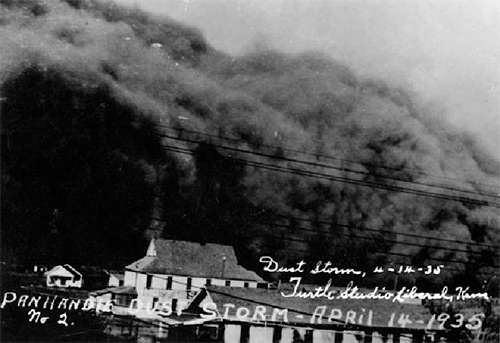Press Release
Eighty Years Ago This Week Dust Bowl Storm Wreaks Havoc on Colorado Plains
Denver - The morning of Sunday, April 14, 1935 started out with sunshine and blue skies, but by the afternoon the temperature had dropped and an ominous black cloud was quickly approaching. This day would soon become known as Black Sunday because of the widespread blackout conditions created from all the winds and dust. Gale-like winds swept across seven different states causing one of the biggest storms during the Dust Bowl.
The Homestead Act of 1862 allowed any American to claim 160 free acres as long as it was farmed for five years. This created a surge in agricultural production generating more crops and fueling the economy. During the 1880’s Baca County, in southeastern Colorado, promised great prosperity. But, the dry climate and isolation caused fluctuations in population. It wasn’t until the invention of the plow and tractor in the 1910s that another boom took place. Traditional natural grasses that had kept the dry soil in place were being plowed for farming. This transition of grassy land to farm fields took place across the U.S. causing the typically dry Western Plains to be exposed to weather elements in ways they hadn’t been before. In the 1930sn drought combined with high winds, created catastrophic storms.
At that time, Baca County had 237,000 acres under wheat production. By 1936 the number had fallen dramatically to 150 acres. The storms had devastated so much land that the government stepped in. With the passing of the Soil Conservation Act of 1935 which educated farmers on better farming practices, along with the Agricultural Adjustment Administration (AAA), to help end the overproduction of farmed foods, change slowly began to take root.
Between 1934 - 1941, hundreds of dust storms blew the dried out and plowed up topsoil of the plains lands all the way to the East Coast. These “black blizzards” have become synonymous with the image of the Dust Bowl and even of the Great Depression, itself. But the storm on April 14, 80 years ago this week, still ranks as one of the most severe storms and triggered the moniker “Dust Bowl.”
The disasters of the Dust Bowl, and the massive storm on Black Sunday, stand as an example to not ignore ecological limits of our land. Preserving soil is imperative, especially as the impending drought season encroaches. To experience what Black Sunday was really like, visit the award-winning Black Sunday Object Theater in the Living West Exhibit at the History Colorado Center to experience Black Sunday.
###
History Colorado's mission is to inspire generations to find wonder and meaning in our past and to engage in creating a better Colorado. We serve as the state's memory, preserving the places, stories, and material culture of Colorado through our museums, educational programs, historic preservation grants, research library, collections, and outreach to Colorado communities. Find History Colorado on all major social media platforms. Visit HistoryColorado.org or call (303) HISTORY for more information.

